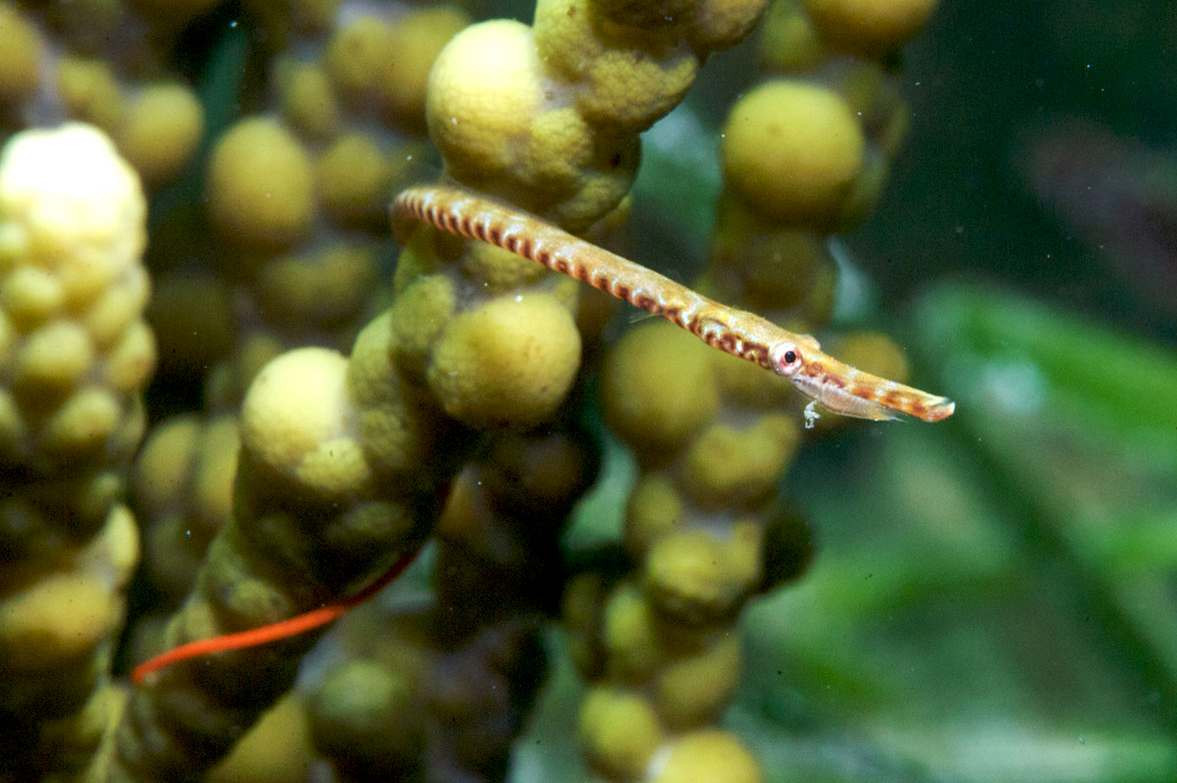Gulf Pipefish, Stigmatopora narinosa Browne & Smith 2007

A Gulf Pipefish, Stigmatopora narinosa, with a parasitic isopod on its snout at Port Hughes Jetty, Gulf St Vincent, South Australia. Source: Graham Short. License: CC by Attribution-NonCommercial-ShareAlike
A very slender pipefish with indistinct trunk and tail ridges, a flattened, slightly elevated snout, and a distinct banded pattern, often with a red tip on the prehensile tail.
The Gulf Pipefish has a very limited distribution, preferring areas with low turbidity and a patchy substrate of brown algae and sparse seagrass in 1-5 m.
Gulf Pipefish, Stigmatopora narinosa Browne & Smith 2007
More Info
|
Distribution |
Endemic to temperate waters of South Australia. The Gulf Pipefish is known only from Spencer Gulf and Gulf St Vincent, preferring areas with low turbidity and a patchy substrate of brown algae and sparse seagrass at 1-5 m. |
|
Features |
Dorsal fin 37–45; Pectoral fin 12–13; Anal fin 2; trunk rings 17–19; tail rings 58–74; subdorsal rings 12.5-9.0 + 7.25–9.0 = 18.5–22.5. Dorsal fin closer to tip of snout than to tip of tail, origin on 6th–8th trunk ring; anal fin tiny, below middle of dorsal fin; caudal fin absent; pectoral fin present. |
|
Size |
To 15 cm TL |
|
Colour |
Colour variable, usually greyish-green above with reddish-brown to dark brown transverse bands centred on the joints between the rings; bands distinctly broader ventrally, and disrupted in some, leaving a mottled pattern; tail tip often red. Juveniles often brown or golden. |
|
Feeding |
Feeds on tiny crustaceans such as mysid shrimps. |
|
Biology |
Oviparous with eggs brooded by the males in a semi-enclosed pouch under the anterior part of the tail that extends for 15-18 rings from the anal ring; pouch plates absent or vestigial; well developed pouch folds meet on the ventral midline; males likely to be brooding at 113mm TL. The specimen with the greatest recorded number of eggs had 3 staggered rows of 64 basal membranous egg compartments on the tail, with the basal layer of eggs covered by a membrane with matching rows of egg pouches; the second layer with 34 eggs within the brood pouch folds resulted in a total of 98 eggs. Males have extended brood patches from December to March, and juveniles < 9.0 cm are seen from December to March. Males mature at 11.3 cm (Browne & Smith 2007). |
|
Conservation |
EPBC Act 1999: Marine Listed Protected in South Australian waters under the SA Fisheries Management Act 2007. |
|
Remarks |
Species in the genus Stigmatopora have a prehensile tail that lacks a caudal fin. |
|
Similar Species |
Stigmatopora narinosa differs from S. nigra in having 9 rather than 6 sub-dorsal tail rings, a greater average number of dorsal rays (40.8 versus 36), subdorsal tail rings (9.08 versus 6.23) and subdorsal rings (19.8 versus 16.8). Although S. narinosa and S. argus both have elongate narrow and shallow snouts, S. narinosa has a shorter, wider and more elevated snout. The brood pouch of S. narinosa extends 15-18 rings from the anal ring compared with 14-24 in S. argus, and 12-16 in S. nigra. |
|
Etymology |
The specific name is from the Latin narinosus (= broadnosed) in reference to the wide and distinctive spatulate shape of the snout. |
|
Species Citation |
Stigmatopora narinosa Browne & Smith 2007, Memoirs of Museum Victoria 64: 2. Type locality: Edithburg Pool, 35°05'S, 137°45'E, South Australia, depth 2 m. |
|
Author |
Bray, D.J. 2025 |
|
Resources |
Gulf Pipefish, Stigmatopora narinosa Browne & Smith 2007
References
Browne, R.K. & Smith, K. 2007. A new pipefish, Stigmatopora narinosa (Syngnathidae) from South Australia. Memoirs of Museum Victoria 64: 1-6. http://doi.org/10.24199/j.mmv.2007.64.1
Carlyle, C. & Pollom, R. 2016. Stigmatopora narinosa (errata version published in 2017). The IUCN Red List of Threatened Species 2016: e.T88342995A115514736. http://dx.doi.org/10.2305/IUCN.UK.2016-3.RLTS.T88342995A88343004.en. Downloaded on 06 February 2019.
Hamilton, H., Saarman, N., Short, G., Sellas, A.B., Moore, B., Hoang, T., Grace, C.L., Gomon, M., Crow, K. & Simison, W.B. 2016. Molecular phylogeny and patterns of diversification in syngnathid fishes. Molecular Phylogenetics and Evolution 107: 388-403 + supplement 1-4 + 5, https://doi.org/10.1016/j.ympev.2016.10.003
Kuiter, R.H. 2000. Seahorses, Pipefishes and Their Relatives. Chorleywood, UK : TMC Publishing 240 pp.
Kuiter, R.H. 2008. Syngnathidae. pp. 448-479 in Gomon, M.F., Bray, D.J. & Kuiter, R.H. (eds). Fishes of Australia's Southern Coast. Sydney : Reed New Holland 928 pp.
Kuiter, R.H. 2009. Seahorses and their relatives. Seaford, Australia : Aquatic Photographics 331 pp.
Short, G. & Trevor-Jones, A. 2020. Stigmatopora harastii, a new species of pipefish in facultative associations with finger sponges and red algae from New South Wales, Australia (Teleostei, Syngnathidae). ZooKeys 994: 105-123. https://doi.org/10.3897/zookeys.994.57160




